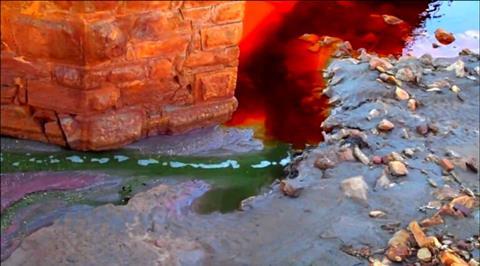Because oxygen-bearing sulfate minerals trap and preserve signals from Earth’s atmosphere, scientists closely study how they form. Sulfates are stable over billions of years, so their oxygen isotopes are seen as a time capsule, reflecting atmospheric conditions while they were evolving on early Earth—and possibly on its planetary neighbor Mars.

A new NASA-funded study led by a University of Utah geochemist examines how sulfate forms when pyrite, commonly known as “fool’s gold,” is oxidized in environments teeming with microbes versus those without them.
READ MORE: Laser-powered device tested on Earth could help us detect microbial fossils on Mars
READ MORE: Trace gases, microbes and life beyond Earth
The researchers focused on Spain’s Rio Tinto, a contaminated river passing through a region where iron and copper were mined for thousands of years. What’s left in the hills of Andalusia may be an environmental calamity, but scientists now regard it as an analog for what the Martian surface may have once been like.
This acidic mine drainage is rich in sulfates and bacteria known to oxidize both sulfur and iron. The research team measured the “triple oxygen isotopes” (ratios of 17O/16O and 18O/16O) in sulfate to figure out how much of the oxygen comes directly from air compared to water.
Direct reaction
“This is the first time where we’ve seen outdoors, not in the lab, that we can perpetuate this direct reaction between O2 and pyrite sulfur if the environmental conditions are just right,” said lead author Issaku Kohl, associate research professor in the Department of Geology & Geophysics.
“Because we’ve been able to identify that niche, we now have geochemical markers or criteria that would allow you to find a similar environment or remnants of a similar environment in the rock record, either on Earth or in an extraterrestrial setting.”
The study homed in on a bacterium called Acidithiobacillus ferrooxidans, believed to be among the earliest clades of microbes, potentially producing energy prior to the evolution of photosynthesis. The research team discovered that in microbe-rich, acidic environments, A. ferrooxidans drives pyrite oxidation in a way that preserves a remarkably high amount, exceeding 80% and up to 90%, of atmospheric oxygen (O₂) in sulfate.
Atmospheric imprint
Unlike lab experiments, where this signal fades quickly as sulfate incorporates O₂ from water, the Rio Tinto microbial-active ecosystem maintains this strong atmospheric imprint.
Accordingly, sulfate deposits don’t just preserve atmospheric and environmental conditions—they may also carry a microbial “biosignature.” Such signatures could help scientists interpret sulfate minerals on Mars or in ancient Earth rocks as a potential record of both atmospheric conditions and microbial activity.
Martian sediments hosted evaporites containing abundant sulfate minerals, but scientists don’t yet know how those sulfates formed.
Telltale signatures
“The current favored hypothesis is that it’s through atmospheric oxidation of volcanic sulfur dioxide (SO₂). But environments like that have telltale geochemical signatures that indicate whether this was likely aerosolized and oxidized in the atmosphere at relatively high temperature and therefore, unlikely to have had life involved,” Kohl said.
But that does not discount the possibility that in localized environments, there could have been hyperacidic fluids that were oxidizing at the water-rock interface, the way Kohl’s experiments and Rio Tinto were producing sulfate.
The study outlines an approach for analyzing oxygen isotope data from Martian sediments for signs of life, should samples ever be brought home to Earth. NASA’s Curiosity and Perseverance rovers have been collecting samples since 2021 and 2012, respectively, with the hope of someday bringing them back on future missions to Earth’s red neighbor.
Two steps away
But Kohl emphasized that the science is still two steps away from being able to determine whether rock samples from Mars bear conclusive evidence of past microbial life. First, the samples would have to be indicative of a very low-pH (acidic) environment, O₂-oxidation-dominant environment, rich in a particular ion of iron(2+).
“We can never get away from our assumptions when we’re trying to relate rock records to environments that we deal with in real time in the modern era,” Kohl said. “If we make the assumption that we know the amount of atmospheric O2 in sulfate, we can back calculate the isotopic composition of the O₂ that was involved in making those sulfates.”
And while we wait for interplanetary voyages to deliver us Martian rocks, these findings could open new lines of investigation into environmental conditions here on Earth billions of years ago, when microbial life began evolving and oxygen first appeared in the atmosphere.
The paper titled, “Triple-oxygen isotopic evidence of prolonged direct bioleaching of pyrite with O2,” appeared online Sept. 30 in Earth and Planetary Science Letters, which releases it in print on Oct. 24. The research was supported by the NASA Astrobiology Institute. Co-authors include Max Coleman of the Jet Propulsion Laboratory; Bryan Killingsworth of the U.S. Geological Survey; Karen Ziegler, University of New Mexico; and Edward Young, University of California, Los Angeles.
Topics
- Acidithiobacillus ferrooxidans
- Bacteria
- Bryan Killingsworth
- Climate Action
- contamination
- Edward Young
- Geomicrobiology
- Healthy Land
- Issaku Kohl
- Jet Propulsion Laboratory
- Karen Ziegler
- Max Coleman
- Microbes and Space
- Nasa
- Research News
- sulfate
- triple oxygen isotopes
- U.S. Geological Survey
- University of California, Los Angeles
- University of New Mexico
- University of Utah
- USA & Canada







No comments yet